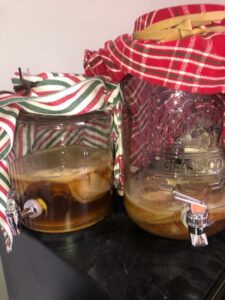Kombuch-huh?

Castleton student Riley Cartwright brews his own kombucha.
The crack of a safety seal, the mild fizzing sound of released carbonation and a smell wafting up that can be described as a mix of incense and body odor. Staring down the mouth of a bottle of GT’s Synergy Watermelon Wonder kombucha, I dutifully took my first ever sip.
Sweet.
Acidic.
And an aftertaste that lingered far longer than I had hoped.
However, I can’t help but wonder how it is that this funky beverage has made its way into health food notoriety, and if it truly is the solution to people’s digestive troubles.
Kombucha is, at its most basic, fermented sweet tea. Fermentation is an anaerobic reaction converting sugars to alcohol or acids. The most common is alcoholic fermentation, however there are many different types. Sauerkraut, for example, is a type of lactic acid fermentation that makes it tart and sour.
Kombucha has a variety of fermentation reactions going on due to the complexity of the symbiotic culture of bacteria and yeast that causes fermentation.
Despite the relatively clear concept, the exact history of kombucha is unclear. There are different accounts floating around as to where it came from, but the most clear course starts in the Manchuria region of China around the year 220 B.C. From China, it is said to have been brought to Japan by the physician Kombu, who brought the tea fungus to cure the digestive problems of the Emperor Inkyo in 414 A.D.
George Thomas Dave, known as “GT Dave,” is widely credited as being the first person in the United States to put bottled kombucha on shelves of grocery stores, as well as being the founder of what is now GT’s Living Foods. GT Dave got into the kombucha business at the age of 15, when he and his family attributed the ultimate positive outcomes of his mother Laraine’s breast cancer diagnosis to her daily consumption of kombucha that GT was brewing in the kitchen. But this was just the beginning of a long and winding road for GT’s Kombucha.
In June 2010, Randy Trahan, a Consumer Protection Inspector for the Maine Department of Agriculture, noticed leaking bottles during a routine bottle audit at Whole Foods in Portland, Maine.
“Being a public health official, I know that alcohol is a by-product of the fermentation process. I could immediately see that there might be a public safety issue,” he said. “Kids could get hold of this and get a buzz.”
When results from samples of four different brands of kombucha from the site came back from the University of Maine Food Sciences Lab with ABV’s ranging from slightly over 0.5% to 2.5% (all in violation of the Alcohol and Tobacco Tax and Trade Bureau ruling on non-alcoholic beverages remaining strictly below 0.5% ABV), there were bound to be repercussions. On June 15, 2010 Whole Foods Market posted signs on the Kombucha shelf: “Key suppliers and Whole Foods Market have elected to voluntarily withdraw Kombucha products in bottles and on tap from our stores at this time due to labeling concerns related to slightly elevated alcohol levels in some products. This is not a quality issue. Sorry for any inconvenience.”
Whole Foods Market wouldn’t see GT Dave’s Kombucha on shelves for another three and a half months.
During the time that GT Dave was off the scene, grassroots brands began to thrive in the space that had become available in the market. Alongside these grassroots brands, or perhaps giving life to them, was a dedicated community of homebrewers. If you can get your hands on part of a SCOBY, some sweetened tea, and a jar, you can brew your own kombucha at home.
Senior Riley Cartwright was inspired to try his hand at homebrew due to the high price of commercially available kombucha.
“I love the stuff, but my wallet was not happy with me, so I sought out other methods,” he said. When asked about the difficulty of home brewing, Cartwright likened the process to watering a plant, saying “it just took a bit of patience and just staying on top of it. Once you got the system down, it became almost second nature.”
However, there can be dangers lurking in your homebrew if you don’t get it right, Assistant Professor of Chemistry Livia Vastag explains.
“The dangers here are really that you can get a microbe that’s a contaminant, a dangerous microbe that ends up populating your beverage…and if you have bad enough luck you could get a microbe that produces a toxic byproduct,” she said.
This is one of the possible consequences that can come from drinking kombucha that hasn’t been properly executed — from the microbes in the SCOBY, to the amount of time that the drink spends fermenting.
Another potential consequence is lactic acidosis, an overproduction of lactic acid that can cause life threatening injury to the liver and kidneys as the body attempts to rid the excess lactic acid. The CDC recommends consuming no more than 12 ounces of kombucha per day in order to avoid instances of acidosis.
But what do current everyday kombucha drinkers think of the potential health benefits? Junior Social Work major Mackenzie Kuban says “I think depending on the brand you can get vitamins and anti-oxidants, but it’s kinda like a juice where you gotta be careful of added sugars and such.”
Senior health education and physical education major Izzy Gogarty is a fan.
“From drinking high-quality kombucha, I found that I was having a lot of benefits from the probiotics in the drink,” she said.
Novice homebrewer Cartwright is equally pleased with his experience.
“I definitely feel much better when I am drinking kombucha. It feels like my body‘s almost thanking me for drinking it, and I feel like I am recharging myself in some weird way,” he said.







